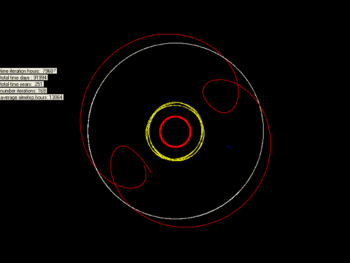55576 Amycus
 Orbital diagram (top view) | |
| Discovery[1] | |
|---|---|
| Discovered by | NEAT |
| Discovery site | Palomar |
| Discovery date | 8 April 2002 |
| Designations | |
| (55576) Amycus | |
Named after | Amycus |
| 2002 GB10 | |
| Centaur [1][2] | |
| Adjectives | Amycian |
| Orbital characteristics[1] | |
| Epoch 13 January 2016 (JD 2457400.5) | |
| Uncertainty parameter 2 | |
| Observation arc | 7204 days (19.72 yr) |
| Aphelion | 35.019 AU (5.2388 Tm) (Q) |
| Perihelion | 15.178 AU (2.2706 Tm) (q) |
| 25.098 AU (3.7546 Tm) (a) | |
| Eccentricity | 0.39526 (e) |
| 125.74 yr (45926.7 d) | |
| 37.041° (M) | |
| 0° 0m 28.219s / day (n) | |
| Inclination | 13.352° (i) |
| 315.45° (Ω) | |
| 239.17° (ω) | |
| Jupiter MOID | 9.92261 AU (1.484401 Tm) |
| TJupiter | 4.133 |
| Physical characteristics | |
| Dimensions | 76.3 ± 12.5 km [3][4] |
| 9.76 h (0.407 d) | |
| ~ 0.18 [3] | |
| ~ 20 [5] | |
| 7.8[1] | |
55576 Amycus /ˈæmɪkəs/, provisional designation 2002 GB10, is a centaur discovered on April 8, 2002, by the NEAT at Palomar.[1]
The minor planet was named for Amycus, a male centaur in Greek mythology.
It came to perihelion in February 2003.[1] Data from the Spitzer Space Telescope gave a diameter of 76.3 ± 12.5 km.[3][4]
A low probability asteroid occultation of star UCAC2 17967364 with an apparent magnitude of +13.8 was possible on February 11, 2009.[6] Another such event involving a star with an apparent magnitude of +12.9 occurred on 2014 April 10 about 10h 46m Universal Time, visible for observers in the southwest USA and western Mexico.[7]
Near 3:4 resonance of Uranus
Amycus (2002 GB10) lies within 0.009 AU of the 3:4 resonance of Uranus and is estimated to have a long orbital half-life of about 11.1 Myr.[8]

See also
References
- ^ a b c d e f "JPL Small-Body Database Browser: 55576 Amycus (2002 GB10)" (2007-08-15 last obs). Retrieved 12 April 2016.
- ^ Marc W. Buie. "Orbit Fit and Astrometric record for 55576" (2003-06-22 using 73 of 81 observations). SwRI (Space Science Department). Retrieved 2009-02-28.
- ^ a b c John Stansberry; Will Grundy; Mike Brown; Dale Cruikshank; John Spencer; David Trilling; Jean-Luc Margot (2007-02-20). "Physical Properties of Kuiper Belt and Centaur Objects: Constraints from Spitzer Space Telescope". arXiv:astro-ph/0702538.
{{cite arXiv}}:|class=ignored (help) - ^ a b Wm. Robert Johnston (22 August 2008). "List of Known Trans-Neptunian Objects". Johnston's Archive. Archived from the original on 13 February 2009. Retrieved 2009-02-28.
{{cite web}}: Unknown parameter|deadurl=ignored (|url-status=suggested) (help) - ^ "AstDys (55576) Amycus Ephemerides". Department of Mathematics, University of Pisa, Italy. Retrieved 2009-03-15.
- ^ Steve Preston (2009-01-08). "Star occultation by asteroid 55576 Amycus". IOTA (International Occultation Timing Association). Retrieved 2009-12-28.[dead link]
- ^ Hans-J. Bode; Filipe Braga Ribas; B. Sicardy (2013). "Bright Star Occultations by TNOs in 2014. J. Occultation Astronomy 2014-1". IOTA (International Occultation Timing Association).
{{cite journal}}: Cite journal requires|journal=(help) - ^ Horner, J.; Evans, N.W.; Bailey, M. E. (2004). "Simulations of the Population of Centaurs I: The Bulk Statistics". Monthly Notices of the Royal Astronomical Society. 354: 798–810. arXiv:astro-ph/0407400. Bibcode:2004MNRAS.354..798H. doi:10.1111/j.1365-2966.2004.08240.x.
{{cite journal}}: Unknown parameter|class=ignored (help)
